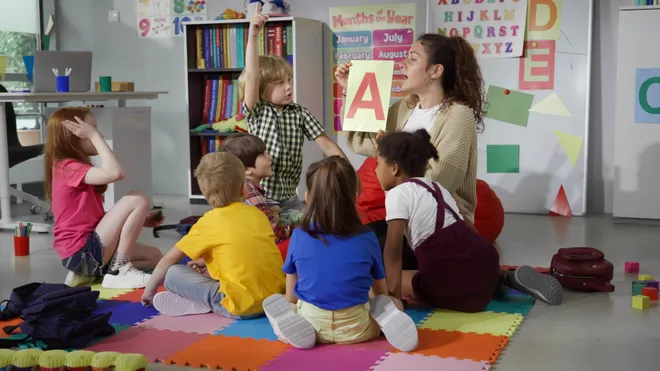Does the alphabet song your kids sing sound new to you? Here's how the change helps them
Have your kids come home singing their ABCs to a familiar tune - but one that somehow sounds just a bit off? You're not imagining it: the alphabet song is changing.
The original song most of us grew up singing (and many of us probably still sing in our heads more often than we'd care to admit) was set to a sing-song melody with pauses between "G," "P," "S," "V" "X" and ended with "Y and Z." Of course, the song closed with the triumphant line, "Now I know my ABCs, next time won't you sing with me?"
The newer version, which has become increasingly common in American primary education, takes the same tune but restructures the phrasing, instead placing the pauses after "G," "N," "Q," "T," "W" and ending with "XYZ." The closing lines are also different, now sung, "Now I never will forget, how to say the alphabet."
The tweak is just enough to make you feel like you're listening in on a slightly parallel universe when you hear it; after all, the actual melody itself is the same.
The reason for the change seems fairly apparent to the average listener. There is no more rushing through the mess that was "LMNOP," which often came out sounding like nothing more than mush mouth. It also removes the "and" between Y and Z, eliminating another potential source of confusion.

As with anything time-honored and beloved tradition, however, some people are resistant to change
"Ugh, how dare you explain the extremely logical reason behind something from my childhood changing," joked one commenter under a TikTok video about the new version. "It’s better. I hate it," and "Ellemenohpee was my favorite letter tho," joked two others. "This version is clearly superior, even though my nostalgia doesn’t want me to admit it," said one comment with 27,000 likes.
Some didn't take the modification in stride so easily though, making arguments like, "I agree with you but didn’t all of us turn out fine knowing how to read and such with the original way of singing the alphabet?" and "I mean if all of us can get it why can’t these new kids get it?" Another commenter contended, "So you’re saying the newer generations couldn’t figure out what millions before them?"
While adults who have had the older version running through their minds since the age of 5 may have some trouble adjusting to the development, one first-grade teacher who focuses on literacy, and specifically on helping kids who struggle with it, explained to USA TODAY the developmental and pedagogical reasons behind what may seem like a silly update.
Keep an eye on your inbox:25 million student loan borrowers to get email on forgiveness
A clearer alphabet song may be a step toward improving literacy
One first-grade teacher, who goes by @teacherrachelsorsel on TikTok, said the change was made to address common confusion that often hindered some kids' understanding of the song.
"When kids struggle with something as 'simple' as the alphabet song, we know that these [reading] skills are going to be tough for them and those are foundational to be able to decode and read," she told USA TODAY.
Rachel specializes in structured literacy, literacy intervention and dyslexia, having clinched an honorable mention in the running for the Nessy Dyslexia International Science of Reading 2023 Teacher of the Year award.
"What research has found is that when kids are first learning to read, they have to develop two skills," she said. "One is called the alphabetic principle....the other skill is called phonological awareness."
These skills allow students to develop a fundamental understanding of letters and the fact they make sounds and spell words. They also enable kids to discern specific sounds in words.
If kids are getting tripped up into thinking "LMNOP" is just a jumble of sounds or the "and" in "Y and Z" is its own letter, it can hinder their ability to expand into basic reading skills.
"A lot of people on my videos comment, 'Oh, why don't you just enunciate?' And of course, we enunciated to make sure the kids understand what we're saying with our mouths," she said. "But it doesn't make a difference because their brain is not developed enough to notice the difference as much as we do as fluent, literate adults."
She also said people ask why teachers can't simply point to visuals of the letters while singing the song. While educators do want to connect visuals to sounds for kids, she explained, those aged around 3-5 who are learning the song do not yet have the neural networks to match the written letters to the sounds.
"To kids, those just look like squiggles," she said. "You have to develop that a lot more slowly than just showing 26 squiggles and saying sounds."

And while some people online have expressed incredulity or annoyance at the change, Rachel said she's had overwhelmingly positive experiences with parents and fellow teachers. Parents of her students often come to her with feedback that they learned something new about phonetics themselves, telling her that new songs and other lessons "make sense" even if it's not what they learned in school.
"You think of [the alphabet] so simply, everybody knows it, but there's actually a lot of stuff little kids' brains are doing when they're learning letters," she explained. "When they're struggling with something as 'simple' as the alphabet song, the whole journey to read is going to be really difficult."
Disclaimer: The copyright of this article belongs to the original author. Reposting this article is solely for the purpose of information dissemination and does not constitute any investment advice. If there is any infringement, please contact us immediately. We will make corrections or deletions as necessary. Thank you.







